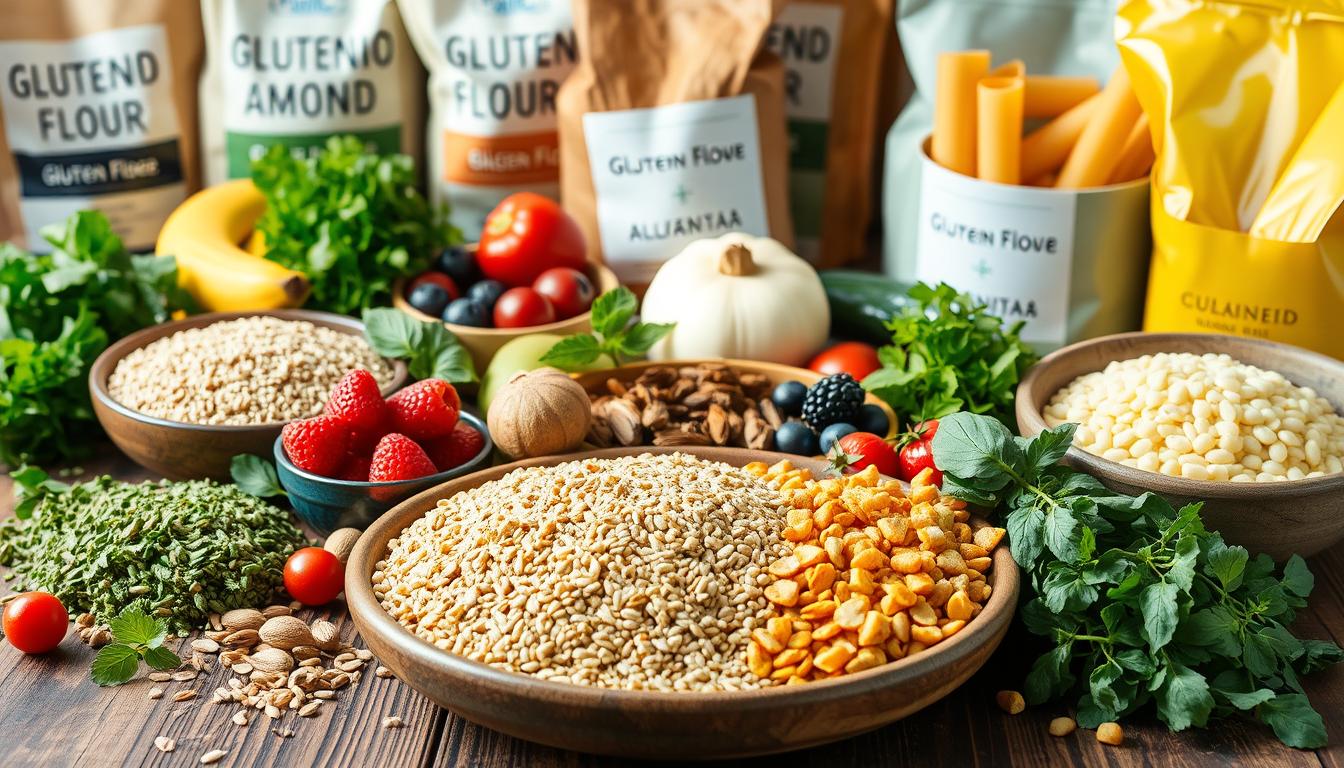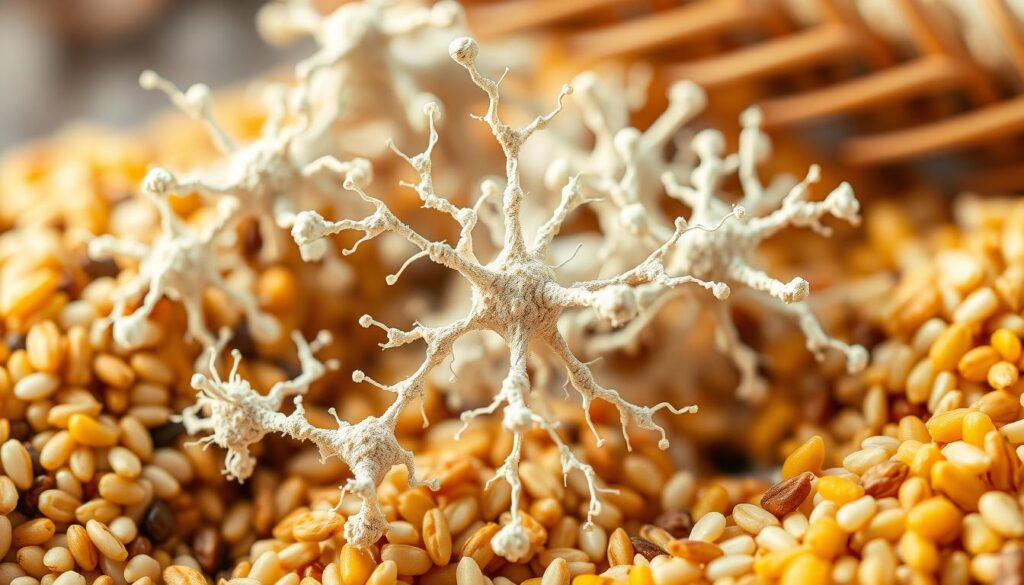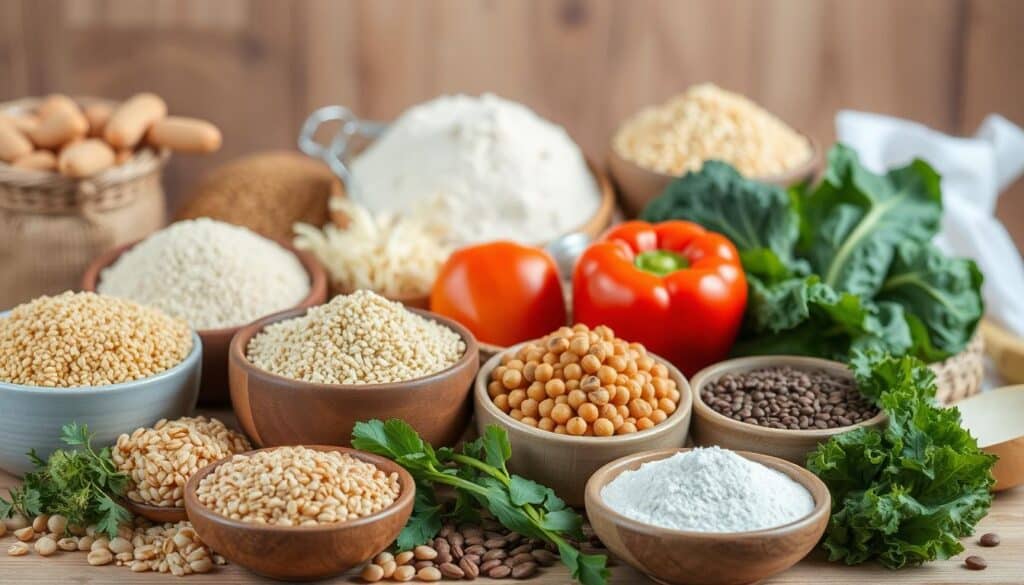What Are the Staples of the Gluten-Free Diet?
Starting a gluten-free diet can feel overwhelming, but with the right staples, it becomes an enjoyable and nutritious lifestyle. Whether you’re managing celiac disease, gluten sensitivity, or simply choosing a gluten-free way of eating, understanding essential gluten-free foods is key to maintaining a balanced diet.
This guide will explore the must-have staples that form the foundation of a gluten-free diet, from naturally gluten-free grains to protein sources and fresh produce. You’ll also learn how to identify hidden gluten in packaged foods and discover delicious gluten-free alternatives to your favorite meals.
If you’re ready to stock your pantry with nutrient-dense, gluten-free essentials and create satisfying meals without gluten, let’s dive into the details!.
Understanding Gluten and Its Effects on Health
Gluten is a protein found in grains like wheat, barley, and rye. For most people, eating gluten is okay. But, some folks might have bad reactions, like celiac disease and gluten sensitivity.
Celiac Disease and Gluten Sensitivity
Celiac disease is an autoimmune disorder. It happens when gluten makes the small intestine hurt. This can cause digestive issues, not getting enough nutrients and other health problems.
Gluten sensitivity is different. People with it feel sick after eating gluten. They might get bloated, have stomach pain, and feel tired. But, it’s not the same as celiac disease.
Why People Choose Gluten-Free Diets
Some people choose to eat gluten-free for many reasons. This includes:
- Feeling better and having less digestive issues
- Helping with other health problems, like joint pain or skin issues
- Feeling more energetic and feeling better overall
Common Sources of Gluten
Gluten is in many foods, like bread, pasta, cereals, baked goods, and some processed foods. If you’re gluten-free, it’s key to know where gluten is. Always check labels to make sure you’re not eating gluten by mistake.
What Are the Staples of the Gluten-Free Die
Starting a gluten-free diet means learning about key foods. These gluten-free staples are full of nutrients and offer tasty alternatives to wheat. They help make your meals balanced and enjoyable.
Grains like rice, quinoa, and ancient grains are essential. They’re great for making pilafs and porridges. Gluten-free flours, like almond and coconut, are perfect for baking.
Fruits and vegetables are also crucial. They’re naturally gluten-free and packed with vitamins and minerals. They help keep you healthy and full of energy.
Don’t forget about protein sources like meat, fish, and eggs. Plant-based options like beans and nuts are also important. They help you get enough protein without gluten.
By using these gluten-free staples in your meals, you can enjoy a healthy diet. Try out different nutritious alternatives and make delicious gluten-free dishes.
| Gluten-Free Grains | Gluten-Free Flours | Fresh Produce | Protein Sources |
|---|---|---|---|
| Rice, Quinoa, Amaranth, Buckwheat | Almond, Coconut, Rice, Cassava | Fruits, Vegetables, Leafy Greens | Meat, Poultry, Fish, Eggs, Beans, Lentils, Nuts |
“Embracing a gluten-free diet doesn’t mean sacrificing taste or nutrition. With the right gluten-free staples, you can create a vibrant and satisfying culinary experience.”
Essential Gluten-Free Grains and Flour
If you’re on a gluten-free diet, it’s key to check out gluten-free grains and flour. You’ll find everything from rice to quinoa and millet. These foods open up a world of tasty and healthy meal options.
Rice Varieties and Their Uses
Rice is a top choice for gluten-free diets. It comes in many types, each with its taste and texture. White rice is soft and light, while brown rice is nutty and chewy.
Basmati rice and jasmine rice are great for adding flavor to dishes. They’re perfect for making fragrant pilafs and side dishes.
Quinoa and Ancient Grains
Quinoa is a nutritional superstar among gluten-free grains. It’s packed with protein and vitamins. Other ancient grains like millet, buckwheat, and amaranth also have unique tastes and uses.
Alternative Flour Options
There are many gluten-free flours beyond wheat flour. Almond flour, coconut flour, and chickpea flour are popular. They’re good for baking and thickening sauces.
Discover the exciting world of gluten-free grains and flour. From rice to quinoa and millet, these ingredients let you make delicious, healthy gluten-free meals.
Fresh Produce and Natural Gluten-Free Foods
Following a gluten-free diet means eating a lot of naturally gluten-free foods. These foods, like fruits, vegetables, nuts, and seeds, are full of nutrients. They help make a gluten-free diet balanced and tasty.
Eating lots of gluten-free whole foods every day gives you important vitamins, minerals, and fiber. These foods are naturally gluten-free. They also come in many flavors, and textures, and offer health benefits.
Vibrant Fruits and Vegetables
Eating a variety of fruits and vegetables is great for your health and follows a gluten-free diet. You can enjoy everything from apples and oranges to leafy greens and carrots. These foods are full of nutrients and fiber.
- Try different fruits and vegetables to keep your meals interesting and full of nutrients.
- Include both raw and cooked produce to get all the vitamins and minerals you need.
- Try new gluten-free whole foods to discover new tastes and recipes.
Nutrient-Dense Nuts and Seeds
Nuts and seeds are key to a good gluten-free diet. They are full of protein, healthy fats, and minerals. These foods help keep you healthy.
- Snack on almonds, walnuts, or pumpkin seeds for a tasty and healthy snack.
- Add nuts and seeds to your meals, like on salads or in smoothies.
- Try different gluten-free whole foods like chia seeds, flaxseeds, and sunflower seeds to get more nutrients.
By choosing naturally gluten-free whole foods, you can feed your body well, enjoy your meals, and live a fulfilling gluten-free life.
| Gluten-Free Whole Foods | Nutritional Benefits |
|---|---|
| Fruits | High in vitamins, minerals, and antioxidants |
| Vegetables | Rich in fiber, vitamins, and phytonutrients |
| Nuts | Packed with protein, healthy fats, and essential minerals |
| Seeds | Excellent source of fiber, protein, and omega-3 fatty acids |
“Embracing a variety of naturally gluten-free whole foods is the key to a nourishing and satisfying gluten-free lifestyle.”
Protein Sources in a Gluten-Free Diet
Following a gluten-free diet means you need to eat well. Luckily, there are many gluten-free protein sources. You can choose from lean meats, poultry, fish, legumes, tofu, tempeh, and eggs.
Meat and Poultry Options
Animal-based proteins include many gluten-free options. You can enjoy chicken, turkey, pork, fish, and seafood. Always pick unprocessed, plain versions to avoid gluten.
Plant-Based Protein Alternatives
Plant-based proteins are great for those who prefer them. Legumes like beans, lentils, and chickpeas are gluten-free and full of fiber. Tofu and tempeh are also good choices, offering protein without gluten.
Safe Seafood Choices;What Are the Staples of the Gluten-Free Die
Adding fish and seafood to your diet can be healthy. Many fish, like salmon, tuna, and tilapia, are gluten-free. Just be careful of cross-contamination when you buy or prepare them.
Exploring these protein sources helps you eat well on a gluten-free diet. Always check labels for hidden gluten. This way, you can enjoy safe and tasty meals.
Navigating Packaged and Processed Foods
Starting your gluten-free journey can be tough. You’ll find it hard to pick out good snacks and packaged foods. It’s key to know how to choose healthy options and understand labels to make sure they’re gluten-free.
Just because a product says it’s gluten-free, it’s not always good for you. Many gluten-free foods have a lot of sugar, unhealthy fats, and additives. Always check the nutrition labels and pick foods that fit your health goals.
- Start with whole, unprocessed gluten-free foods like fresh fruits, lean meats, and gluten-free grains.
- For packaged gluten-free foods, choose ones that are not heavily processed and have simple ingredients.
- Watch out for hidden gluten in foods like soy sauce, modified food starch, and some flavorings.
- Look for gluten-free certification labels. They show the product has been tested and is gluten-free.
By learning to read labels well and choosing whole foods, you can confidently pick out gluten-free items. This way, you can keep your diet healthy and gluten-free.
“The key to a successful gluten-free diet is to focus on whole, unprocessed foods, while being mindful of the ingredients in packaged items.”
Reading Labels and Hidden Sources of Gluten
Finding gluten-free foods can be hard, especially with food labels. It’s key to know gluten-free certification symbols and find hidden sources of gluten in foods. This helps keep your diet safe and healthy.
Certification Labels and What They Mean
When you’re looking for gluten-free products, check for certified labels. Look for the Gluten-Free Certification Organization (GFCO) seal, the National Celiac Association logo, and the Celiac Sprue Association certification. These labels mean the product has been tested and has less than 20 parts per million of gluten.
Common Hidden Ingredients to Avoid ;What Are the Staples of the Gluten-Free Die
Even if a product says it’s gluten-free, always check the food labels for hidden sources of gluten. Some common ones to watch out for include:
- Wheat-based ingredients like flour, bread crumbs, or malt
- Barley, rye, and triticale, which are also sources of gluten
- Soy sauce, which may contain wheat
- Processed meats, such as hot dogs and sausages, that may contain gluten-containing fillers
Also, be aware of cross-contamination risks. This is when gluten is accidentally added during making or preparing. Always read labels well and contact manufacturers if you’re unsure.
“Identifying hidden sources of gluten and understanding certification labels are essential for a safe and successful gluten-free diet.”
Building a Complete Gluten-Free Pantry
Having a gluten-free pantry full of essentials is key for meal planning. It lets you make a variety of tasty, gluten-free dishes. With the right kitchen essentials, you can quickly make healthy, satisfying meals that fit your diet.
Begin by stocking up on different gluten-free grains like quinoa, brown rice, and gluten-free oats. These grains are great for many recipes, from grain bowls to porridge. Also, get a range of gluten-free flours like almond, coconut, and rice flour. They’re perfect for baking and thickening sauces.
Make sure to add canned and jarred goods to your pantry. Items like gluten-free broths, tomatoes, beans, and lentils are great for many gluten-free meals. They make planning meals easy.
Finally, include a variety of condiments, herbs, and spices in your gluten-free pantry. Tamari and dried herbs can turn simple dishes into amazing meals.
| Gluten-Free Pantry Staples | Kitchen Essentials | Meal Planning Tips |
|---|---|---|
|
|
|
Building a full gluten-free pantry gives you all the kitchen essentials for making many delicious, healthy meals. This makes meal planning easy and fun.
“A well-stocked gluten-free pantry is the foundation for a healthy and satisfying lifestyle.”
Conclusion: What Are the Staples of the Gluten-Free Die
Starting your gluten-free lifestyle can be exciting. You’ll find many tasty and healthy choices. By trying different gluten-free grains, fresh veggies, and proteins, you can make a balanced diet that fits your needs.
Don’t see it as giving up but as a chance to explore. Try new foods, make new recipes, and grow your cooking skills. With some creativity and a focus on health, you can make a gluten-free lifestyle that’s both good for you and enjoyable.
When you start, be sure to stay informed and read labels carefully. Having a supportive group around you helps too. With the right attitude and tools, you can do well on a gluten-free diet. Start this journey with confidence and enjoy every meal.
FAQ; What Are the Staples of the Gluten-Free Die
What are the key staples of a gluten-free diet?
A gluten-free diet includes rice, quinoa, and ancient grains. It also has alternative flours like almond, coconut, or chickpea. Fresh fruits, vegetables, nuts, seeds, and lean proteins are also key. Dairy products that are naturally gluten-free are part of it too.
Why do some people choose to follow a gluten-free diet?
Some follow a gluten-free diet for health reasons. It helps manage celiac disease or gluten sensitivity. It can also reduce digestive issues and is a personal choice.
What are the common sources of gluten that should be avoided?
Wheat, barley, rye, and triticale are main gluten sources to avoid. Gluten can also be in processed foods, condiments, and some medications. Always check labels and watch for cross-contamination risks.
How can I identify certified gluten-free products?
Look for the Gluten-Free Certification Organization (GFCO) logo or the Celiac Sprue Association (CSA) seal. These labels mean the product has less than 20 parts per million of gluten. This is the standard for gluten-free products.
What are some nutritious gluten-free grains and flours I should incorporate?
Great gluten-free grains include rice, quinoa, millet, buckwheat, and amaranth. Try using almond, coconut, chickpea, and oat flour for gluten-free baking.
How can I build a well-stocked gluten-free pantry?
Start with gluten-free pasta, bread, crackers, cereals, and baking mixes. Don’t forget gluten-free spices, condiments, oils, and vinegar. Add fresh produce, nuts, seeds, and lean proteins for a nutritious pantry.



